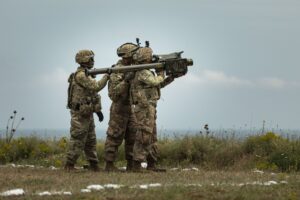The Army’s top acquisition executive said Wednesday the service is likely headed for a competition to find a Stinger missile replacement after a recent Request for Information (RFI) to industry yielded a “lot of really good responses with high-technology readiness levels.”
“My assumption for that is we are proceeding with a full-up competition for that since we saw a lot of promising technology across the board,” Doug Bush, the assistant secretary of the Army for acquisition, logistics and technology told reporters.

The Army released an RFI in late March for its effort to find a Stinger replacement, dubbed the Maneuver Short Range Air Defense Inc. 3, detailing plans to begin developing and testing new capabilities next fiscal year before beginning production of 10,000 missiles in fiscal year 2027 (Defense Daily, April 11).
The RFI noted the Army was particularly interested in weapon systems capable of conducting technology demonstrations in FY ‘24 and live fire engagements in FY ‘26.
Army officials in the RFI detailed the need for a replacement system “to meet increasing demand and growing threat capability,” noting the Stinger-Reprogrammable Microprocessor will become obsolete in FY ‘23 and that the “current Stinger inventory is in decline.”
Lawmakers have recently urged the Pentagon to establish a plan for replenishing the department’s stockpile of Stinger missiles that’ve been transferred to Ukraine and called for prioritizing getting a modernized SHORAD system in place (Defense Daily, March 18).
As of July 22, the U.S. has provided over 1,400 of Raytheon Technologies’ [RTX] Stinger anti-aircraft missiles to support Ukraine in its fight against Russia’s ongoing invasion.
Bush said the focus on developing a Stinger replacement system will work in parallel with efforts to replenish current inventories of the weapon, to include refurbishing older missiles.
“So I think we’re right now doing both at the same time, which is we’ll be producing Stinger missiles for some number of years while also starting a new development program for the missile that follows it,” Bush told reporters. “We are also looking at refurbishing some older Stinger missiles to make sure we can add those to our existing inventories. That’ll help with stock levels.”
The Army in late May awarded Raytheon a $624.6 million deal for procurement of Stingers to the first production order for the system since 2005, as the Pentagon works to activate production lines for critical munitions the U.S. has been providing to Ukraine (Defense Daily, May 27).